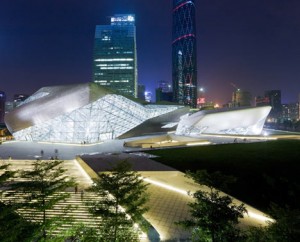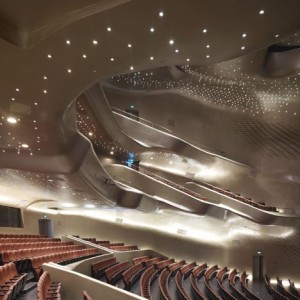Guangzhou Opera House is a newly constructed Chinese opera house in Guangzhou, Guangdong province, People’s Republic of China. 
Designed by Ms Zaha Hadid, the first female winner of the Pritzker Architecture Prize, and Sir. Harold Marshall, the unique acoustic designer from Australia, who won the world top award – the Wallace Clement Sabine Medal, GOH is regarded as the largest, most high-tech as well as the best-facilitated comprehensive performing arts centre in South China. The Canton fair 2013 will be helded in Guangzhou, maybe you can go to the Guangzhou Opera House if you have a time. And Canton Fair Hotel Packages with greater savings, plus a wide range of experiencing tour around China & Indochina. Check out our great offers for you now! http://www.cantontradefair.com/hotels/earlybird_cantonfair.htm
Fold lines in this landscape define territories and zones within the Opera House, cutting dramatic interior and exterior canyons for circulation, lobbies and cafes, and allowing natural light to penetrate deep into the building.

The 1,800-seat auditorium of the Opera House houses the very latest acoustic technology, and the smaller 400-seat multifunction hall is designed for performance art, opera and concerts in the round.
The Opera House will enhance urban function with the area between the Museum and the Opera House functioning as a “Cultural Plaza” overlooking the Pearl River.